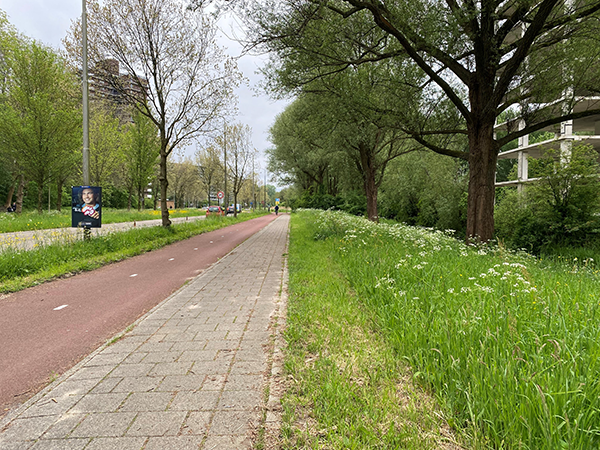Mowing
Zoetermeer is a green city and we want to keep it that way, but it must also remain a safe city. This way the city is attractive to people and animals. In our mowing policy we take biodiversity and safety into account extensively.
Biodiversity
A city with many different plants and animals is healthy for humans. For example, plants and animals provide clean air, fresh water and pollination of plants that provide us with food. In short, more biodiversity makes for a healthier city. To ensure that there is always enough food and living space for plants and animals, we mow more often in one place than in another. We also perform a flora and fauna scan before mowing. This checks whether there are valuable animals or plants in an area and if so, mows around it.
Roadsides and lawns
How often we mow depends on the area. So it could be that on one side of the park a lawn has been mowed, but a verge on the other side of the park has not.
Lawns, such as grass fields and playgrounds, are mowed regularly. We deliberately allow verges to become overgrown. We mow most verges only twice a year and we do this in phases. This means that not everything is mowed at the same time. In this way, we try to achieve the longest possible flowering period. In addition, we also skip certain parts that remain standing all summer. This creates seeds that ensure that the flowers bloom again the following year. This gives native plants and flowers more space to grow and animals, such as insects, more space to live.
Not mowing is not an option
If we were not to mow, the verge would become overgrown. This means that only grass species would be able to grow there and native plants, such as the wild orchid, would disappear. We want to prevent this. In addition, by mowing we create a second flowering round. Places that have been mowed in one phase will be in bloom again after about six weeks. It may seem as if nature disappears by mowing, but this is not the case. By mowing and not doing this everywhere at the same time, we ensure a longer flowering period and there is longer food and shelter for animals and insects.
Safety
We also take safety into account. In places where tall grass impairs visibility in traffic, mowing is done more often. We also call these places visual angles, for example at intersections, roundabouts and pedestrian crossings. Mowing more often at visual angles is important for safety and is not a problem for nature. Because mowing is done less in other places, there is still enough living space for animals.
When and how often is mowing done?
When we mow depends on the season, weather and type of grass or lawn. The Annual Maintenance Program tells you when to expect mowing and the mowing map shows what type of grass or lawn is in your area.
Grass awns
A grass awn can easily end up in the fur, nose, ears, eyes and toes of your pet and crawl into the body. This can cause painful complaints. The municipality cannot stop the growth of grass awns, but we do take measures to limit them. In addition to walking paths that run along tall grass, we mow a strip of one meter wide, more often and shorter than in other places. This reduces the chance of grass awns. The mowers that we use here pulverize the grass, which means that grass awns cause less nuisance. This means that the cuttings do not have to be cleared away.
What can you do about grass awns?
- Be careful when your pet walks through grass.
- Keep your pet on a leash.
- Check your pet if it has been outside.
- If you see a grass awn, remove it with tweezers or go to the vet.

Want to know more?
Do you have a question about our mowing policy? Please see the answers to the most frequently asked questions below. Is your question not listed? Please contact us. You can file a report via Reporting residential and living environment (public space) .
